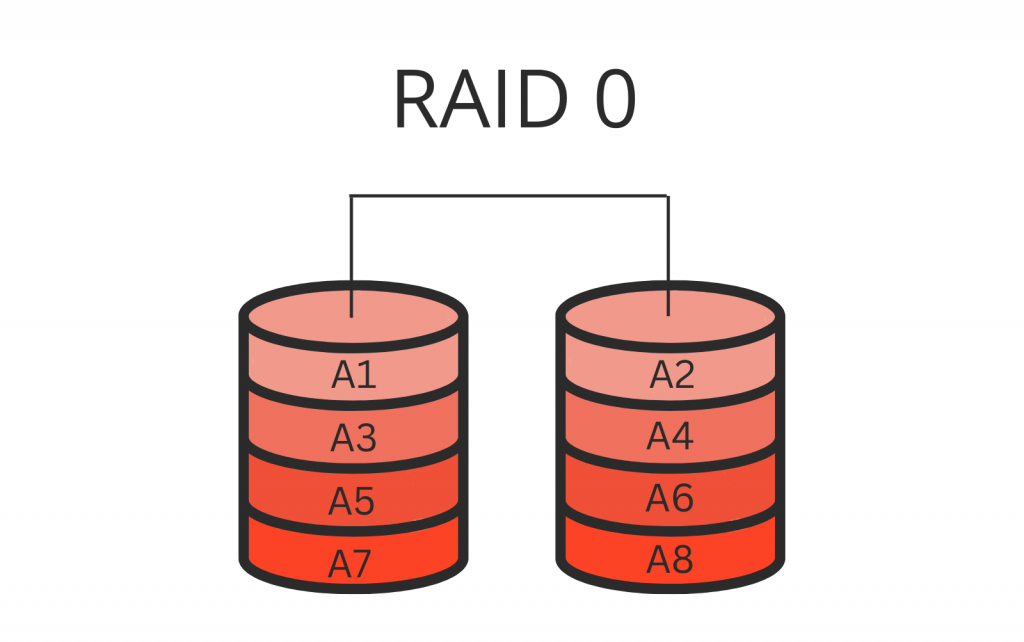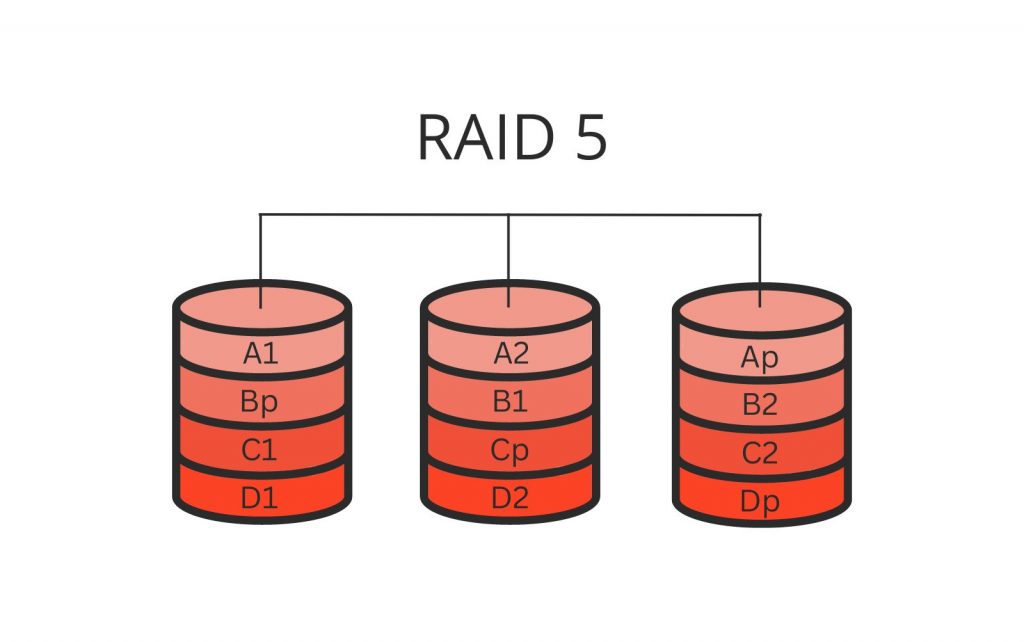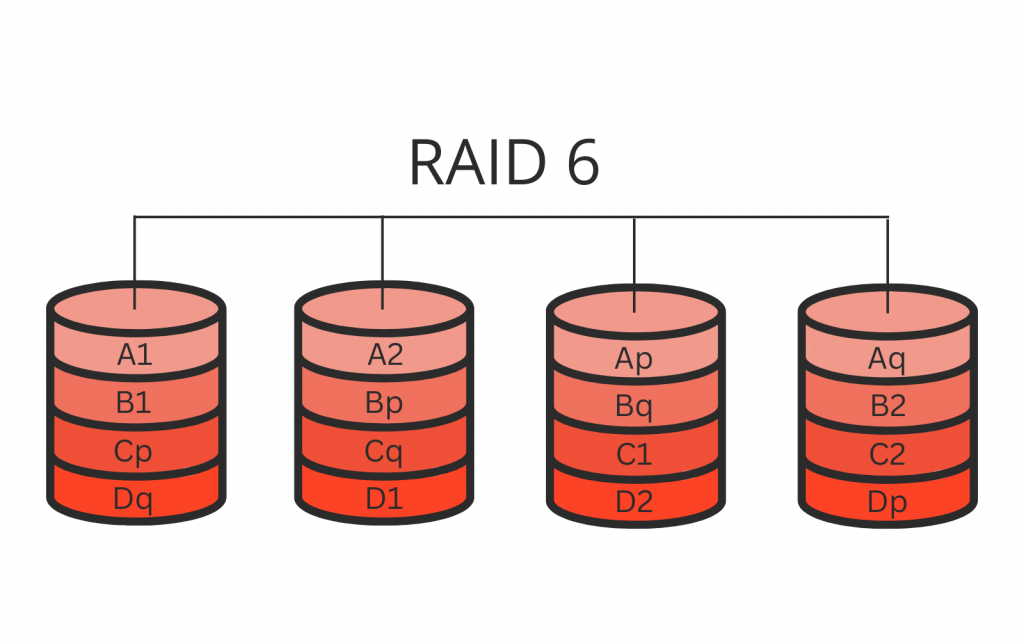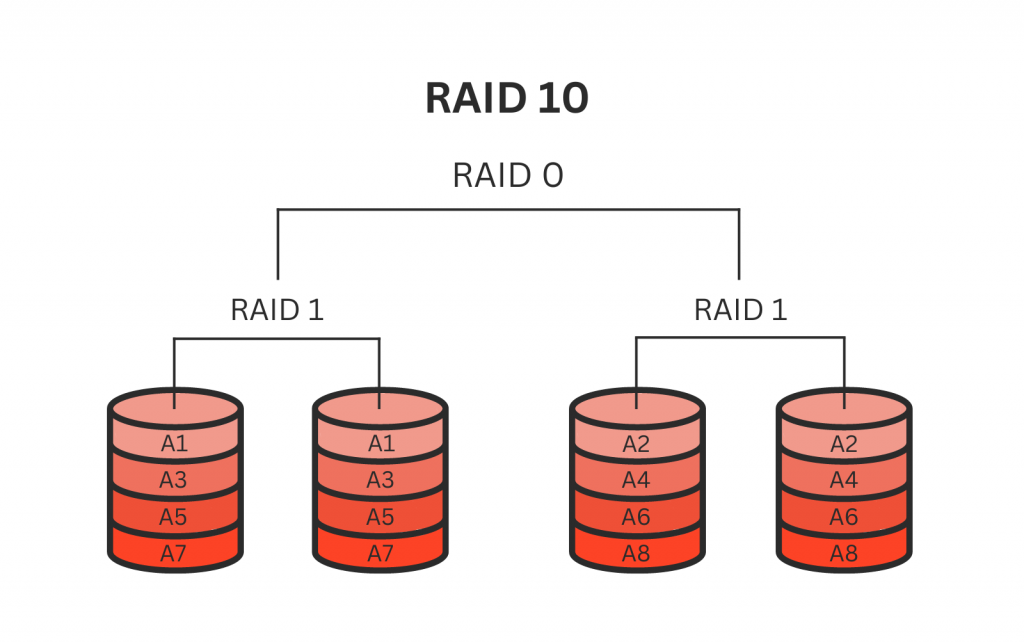RAID (Redundant Array of Independent Disks) represents a technological paradigm employed within computer systems for data storage and safeguarding. Distinct RAID configurations exist, each possessing distinctive attributes, advantages, and limitations.
RAID Array Clarification - Elucidating RAID
RAID stands as a data storage innovation, amalgamating multiple physical disk drives into a coherent entity to ameliorate data dependability and operational efficiency. Employing methodologies such as mirroring, striping, and parity, it achieves redundancy and data preservation.
Through the distribution of data across multiple disks, RAID also furnishes escalated read/write velocities alongside resilience in the event of disk malfunctions. The realisation of RAID can transpire through hardware or software routes, encompassing a range of RAID levels, each bearing its own traits and advantages.

RAID 0 Arrangement
For individuals necessitating rapid data transfer rates, such as those engaging in video editing and gaming, RAID 0 emerges as a favoured selection. By fragmenting data across numerous disks, RAID 0 augments the data transfer velocity, thereby enhancing comprehensive system performance. As the data is striped across these disks, concurrent reading and writing can be executed on each drive, reducing in the mitigation of overall access duration. Nevertheless, an inherent drawback associated with RAID 0 lies in its deficiency of redundancy provision.

Lacking mirroring or parity mechanisms for data retrieval, a single disk failure can result in the complete loss of all stored data. This susceptibility to data loss renders RAID 0 less dependable, particularly for pivotal applications necessitating data safeguarding. It is imperative to recognise that utilising RAID 0 for the storage of vital or irreplaceable data is ill-advised, as it confers no safeguard against data compromise due to drive malfunction.
Furthermore, it is noteworthy that RAID 0 does not yield any benefits pertaining to random access time, thereby potentially rendering it unsuitable for applications such as databases that hinge upon swift read/write velocities. In the broader context, RAID 0 finds its optimal utility within scenarios prioritising performance, while data vulnerability is of lesser concern. Instances such as video editing, gaming, or non-essential data retention align with the strengths of RAID 0. As a cost-effective avenue to enhance system efficiency, it remains a commendable choice when judiciously applied. Nonetheless, a judicious evaluation of potential data loss hazards remains imperative prior to adopting RAID 0 as a storage solution.
RAID 1 Configuration
RAID 1 stands as a favoured preference among users necessitating elevated data redundancy and dependability. Through the creation of an exact duplicate of data across two or more drives, RAID 1 bestows redundancy, thereby ensuring the availability of data in the event of a solitary drive malfunction. The mechanism of RAID 1 entails the identical inscription of data onto multiple drives, rendering it an efficacious recourse for applications demanding heightened accessibility and reliability.
A noteworthy advantage attributed to RAID 1 is its facilitation of commendable read performance, as data retrieval can be executed from any of the integrated drives. Nonetheless, the pace of data inscription can exhibit sluggishness, given that data must be concurrently inscribed onto multiple drives. As each drive contains a complete replication of the data, the efficiency of read performance is equally enhanced, given that numerous drives can be accessed in parallel.
Further to this, RAID 1 yields the advantage of simplicity in implementation, requiring no specialised hardware or software components. This renders it an appealing alternative for small enterprises or individuals seeking data redundancy while aiming to circumvent investment in intricate storage methodologies. A drawback inherent to RAID 1 lies in its comparatively diminished storage capacity efficiency, as data undergoes mirroring across all incorporated drives. Consequently, the aggregate storage capacity of the array equals to that of an individual drive.

Moreover, it should be noted that RAID 1 entails greater expenditure than alternative RAID configurations due to its necessitation of a heightened count of drives to accomplish redundancy.
On the whole, RAID 1 stands as a commendable choice for scenarios demanding elevated availability and data redundancy. Its implementation is straightforward, coupled with a commendable read performance, thereby rendering it a favored selection among small enterprises and individuals.
Nonetheless, it is imperative to meticulously deliberate upon the supplementary financial outlay and ramifications concerning storage capacity when electing RAID 1 as a storage remedy.
RAID 5 Configuration
RAID configuration 5 emerges as a prominent preference for users seeking superior performance coupled with robust data redundancy. Operating along parallel lines with RAID 0, RAID 5 employs striping to heighten performance while concurrently incorporating parity data to deliver redundancy.
Within the framework of RAID 5, data undergoes distribution across numerous drives, bolstered by parity information that facilitates data recovery in the event of drive malfunction. Remarkably, RAID 5 can withstand the loss of a single drive without compromising data integrity, rendering it an exceptionally dependable and efficient storage proposition.
An attribute to note is that RAID 5 offers a judicious equilibrium between performance, storage capacity, and data redundancy. By virtue of data striping across multiple drives, RAID 5 affords elevated read and write performance capabilities.

The presence of parity data, integral to this configuration, underscores redundancy, thereby ensuring uninterrupted data availability in scenarios involving drive failure. Notably, RAID 5 outperforms RAID 1 in terms of storage capacity efficiency, necessitating merely an additional drive for parity data incorporation. Notwithstanding, one potential drawback inherent in RAID 5 resides in its susceptibility to data loss during the process of drive rebuilds.
This undertaking can be time-intensive, rendering the array susceptible to further drive failures throughout this interim. To temper this exposure, the implementation of a robust backup solution becomes imperative. On a comprehensive note, RAID 5 presents itself as a dependable and proficient storage solution, achieving a judicious equilibrium between performance and data redundancy. Its appeal is accentuated among applications necessitating heightened read and write performance alongside data reliability, typified by databases and file servers. However, the consideration of potential hazards linked to data loss during drive rebuilds remains pivotal, calling for the establishment of a backup mechanism to counteract this jeopardy.
RAID 6 Configuration
RAID 6 emerges as a high-performance storage solution, offering an augmented tier of redundancy compared to its RAID 5 counterpart. Within RAID 6, data undergoes striping across multiple drives, accompanied by parity data for redundancy assurance. Notably, in contrast to RAID 5, RAID 6 encompasses an extra parity block, thus equipping it to restore data in scenarios where two drives malfunction simultaneously.
The added parity block in RAID 6 affords a considerable edge over RAID 5 concerning data integrity. With two such parity blocks, RAID 6 can withstand the failure of up to two drives within the array without incurring data loss.
This attributes to its suitability as an optimal resolution for sophisticated applications demanding the utmost in data reliability, such as expansive databases or comprehensive data centres. Parallel to RAID 5, RAID 6 similarly confers elevated read and write performance through the distribution of data across multiple drives.
However, due to the inclusion of an added parity block, RAID 6 necessitates heightened processing power compared to RAID 5, a factor that may marginally affect performance. An inherent potential downside pertaining to RAID 6 involves the stipulation of a minimum of four drives for implementation, coupled with a lower efficiency in storage utilisation compared to RAID 5. Given that RAID 6 comprises two parity blocks, the attainment of redundancy mandates the inclusion of two additional drives, in contrast to RAID 5’s single supplementary drive requirement.

Consequently, the cost per terabyte of storage for RAID 6 surpasses that of RAID 5. On a broader note, RAID 6 presents itself as a commendable choice for scenarios prioritising maximal data reliability and redundancy. Its supplementary parity block endows an additional layer of safeguarding against simultaneous drive failures, rendering it the pinnacle choice for elite applications where any form of data loss is intolerable. Nevertheless, the augmented cost and diminished storage efficiency, when juxtaposed with RAID 5, might render it less appropriate for certain applications.
RAID 10 Configuration
RAID 10, also acknowledged as RAID 1+0, embodies a fusion of RAID 1 and RAID 0 methodologies. This synthesis imparts elevated echelons of both performance and redundancy, rendering it an exemplary recourse for applications mandating the simultaneous fulfillment of these dual requisites.
Within the ambit of RAID 10, data undergoes an initial mirroring process across pairs of drives, akin to the principles of RAID 1. Consequentially, each data block is simultaneously inscribed onto two drives, securing redundancy should a single drive encounter a malfunction. Subsequently, these mirrored pairs are amalgamated through striping, reminiscent of RAID 0, thereby enhancing operational performance. This striping mechanism facilitates the concurrent reading and writing of data across multiple drives, thereby augmenting read and write velocities. RAID 10 stands out as one of the most resilient RAID configurations, as it encapsulates both the advantages of redundancy and performance enhancement. Should a drive encounter failure, the system can sustain seamless operation, unhampered by disruption, as the data remains accessible through the mirrored counterpart.

This renders RAID 10 a compelling selection for pivotal applications that cannot tolerate any operational interruptions, exemplified by expansive databases or web servers. One conceivable drawback associated with RAID 10 lies in its requirement for a minimum of four drives for successful implementation. This factor can lead to heightened costs and diminished storage efficiency when compared to other RAID configurations that demand a lesser number of drives.
All things considered, RAID 10 emerges as a highly endorsed RAID level for those seeking the convergence of remarkable performance and redundancy. The amalgamation of mirroring and striping within this framework not only safeguards against data loss but also augments performance, thereby establishing it as an optimal choice for mission-critical applications.
Deciphering RAID Levels - Opting for the Appropriate Choice
Selecting the most suitable RAID level necessitates a meticulous assessment of multiple variables, encompassing storage requisites, data preservation imperatives, and performance objectives. For instance, if performance takes precedence over data redundancy, RAID 0 could prove optimal. However, in scenarios prioritising data safeguarding, the suitability of RAID 1 or RAID 6 might come to the forefront.
RAID 5 presents a commendable equilibrium between operational efficiency and data safeguarding, whereas RAID 10 affords elevated performance alongside substantial data redundancy. The decision regarding the preferred RAID level shall ultimately hinge upon your precise requirements and financial considerations. It remains imperative to conduct a thorough analysis of the available alternatives and engage in consultation with an adept professional to ascertain the RAID configuration most aligned with your unique use case.
Frequently Asked Questions
What does RAID encompass, and what are the distinct RAID levels?
RAID, an acronym for Redundant Array of Inexpensive Disks, constitutes a technological approach that amalgamates multiple tangible disk drives into a coherent entity, thereby fostering enhanced data reliability, availability, and performance. Various RAID levels, comprising RAID 0, RAID 1, RAID 5, RAID 6, and RAID 10, exhibit distinctive attributes and corresponding advantages.
Which RAID level is optimally geared toward data redundancy?
RAID configurations that embrace data redundancy encompass RAID 1, RAID 5, RAID 6, and RAID 10. RAID 1 involves mirroring, whereas RAID 5 and 6 utilise parity mechanisms to avert data loss attributed to disk failure. Notably, RAID 10 synthesises striping and mirroring to offer both heightened performance and data redundancy.
Which RAID level attains peak performance?
RAID 0 is primed for optimum performance, as it integrates striping without concomitant redundancy. RAID 5 and RAID 6 strike a salient equilibrium between performance and data redundancy, while RAID 10 strikes a balance between high performance and robust data redundancy.
Is it feasible to integrate diverse disk types within a RAID array?
The viability of intermingling varied disk types hinges upon the particular RAID level. Certain RAID configurations, such as RAID 0 and RAID 1, can accommodate differing disk sizes and types, while others, namely RAID 5 and RAID 6, necessitate disks of uniform size and speed. The juxtaposition of diverse disk types can potentially precipitate diminished performance or data compromise.
We’re Here to Help
Our experienced team is committed to helping you recover your critical data. No matter the situation, we work diligently to ensure the best possible outcome. Take action now and let us restore what’s important to you.
Start Recovery Process
"*" indicates required fields


